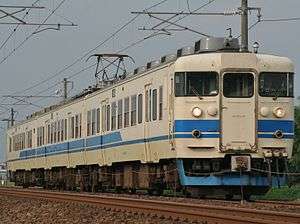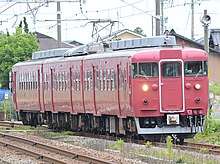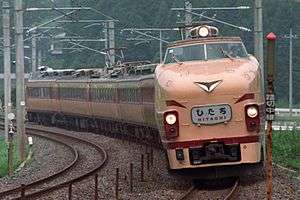413 series
The 413 series (413系, 413-kei) is a Japanese dual-voltage (1,500 V DC and 20 kV AC 60 Hz) electric multiple unit (EMU) train type first introduced by Japanese National Railways (JNR) in March 1986, and later operated on local services on the Hokuriku Main Line by the West Japan Railway Company (JR-West) from 1987[1] and also by the third-sector railway operating company Ainokaze Toyama Railway from March 2015. The units were built by re-using the underframes, bogies and electrical equipment from former 471 series and 473 series express-type EMUs with new suburban type bodies based on the design of the 417 series EMUs introduced in 1978.[1]
| 413 series | |
|---|---|
 JR West set B9 in August 2010 | |
| Constructed | 1985-1989 |
| Entered service | March 1986 |
| Number built | 31 vehicles (11 sets) |
| Number in service | 31 vehicles (11 sets) |
| Formation | 3 cars per trainset |
| Fleet numbers | B01-B11 |
| Operator(s) | JNR (1986–1987) JR-West (1987–) Ainokaze Toyama Railway (2015–) |
| Depot(s) | Kanazawa |
| Line(s) served | Hokuriku Main Line Ainokaze Toyama Railway Line |
| Specifications | |
| Car body construction | Steel |
| Car length | 20,000 mm (65 ft 7 in) |
| Width | 2,950 mm (9 ft 8 in) |
| Doors | 2 pairs per side |
| Maximum speed | 110 km/h (70 mph) |
| Electric system(s) | 1,500 V DC, 20 kV AC, 60 Hz overhead catenary |
| Current collection method | Pantograph |
| Track gauge | 1,067 mm (3 ft 6 in) |
Variants
- 413-0 series: 29 cars converted from former 471 series cars
- 413-100 series: two cars (KuMoHa 413-101 and MoHa 412-101) converted from former 473 series cars
Operations
JR-West trainsets are used on the Nanao Line, Hokuriku Main Line, and IR Ishikawa Railway.[2] Ainokaze Toyama Railway trainsets are used on the Ainokaze Toyama Railway, IR Ishikawa Railway, and Echigo Tokimeki Railway.[2]
Formations
As of 1 April 2017, all 31 of the 413 series cars built are in service, with six three-car sets (including two 455 series cars) operated by JR-West and five three-car sets operated by Ainokaze Toyama Railway.[2]
Trainsets consist of two motored ("Mc" and "M") cars and a non-powered driving trailer ("Tc") car, with the Tc car at the Kanazawa end.[2]
| Designation | Mc | M' | Tc' |
|---|---|---|---|
| Numbering | KuMoHa 413 | MoHa 412 | KuHa 412 |
 KuMoHa 413-3 of set B03 in June 2011
KuMoHa 413-3 of set B03 in June 2011 MoHa 412-3 of set B03 in June 2011
MoHa 412-3 of set B03 in June 2011 KuHa 412-3 of set B03 in June 2011
KuHa 412-3 of set B03 in June 2011
- The MoHa 412 car is fitted with one PS21 lozenge-type pantograph.[2]
- Sets B04 and B11 have a KuHa 455-700 driving car at the west (Kanazawa) end.[2] These were converted from former SaHa 455 intermediate cars.[1]
- Set B11 includes 413-100 series cars KuMoHa 413-101 and MoHa 412-101.[2]
 KuHa 455-701 in set B04 in April 2006
KuHa 455-701 in set B04 in April 2006- Set B04 in July 2013, with its KuHa 455 driving car visible at the rear end
Interior
Passenger accommodation consists of a mixture of transverse four-person seating bays and longitudinal bench seating.[1]
- Interior of a refurbished 413 series set in February 2015
 The interior of 455 series car KuHa 455-702 included in 413 series set B11
The interior of 455 series car KuHa 455-702 included in 413 series set B11
History
The eleven three-car sets were built between 1985 and 1989.[3]
From 14 March 2015, five 413 series sets (B01 to B03, B07, and B10) were transferred from JR-West ownership to the third-sector railway operating company Ainokaze Toyama Railway, which took over control of the section of the former Hokuriku Main Line within Toyama Prefecture when it was separated from the JR-West network, coinciding with the opening of the Hokuriku Shinkansen extension from Nagano to Kanazawa.[4] The former identities of the trainsets operated by Ainokaze Toyama Railway are as follows:[2]
| Set No. | Former JR-West No. |
|---|---|
| AM01 | B01 |
| AM02 | B02 |
| AM03 | B03 |
| AM04 | B07 |
| AM05 | B10 |
In 2016, Ainokaze Toyama Railway set AM03 was modified at JR-West's Kanazawa Workshop for use as a special-event train, receiving Toyama Emaki (とやま絵巻) branding and a new external livery.[5]
Future developments
From the first half of fiscal 2018, an Ainokaze Toyama Railway 413 series set will be rebuilt as a tourist train, returning to service on the line in the second half of fiscal 2018.[6]
Livery variations
Initially painted in maroon with a white stripe, the sets later received the JR-West "New Hokuriku" livery of "oyster white" with "light cobalt blue" lining.[3] From 2012, some sets received the overall blue (color code "DIC N-897") livery applied to JR-West Kanazawa area local trainsets, however, the JR-West fleet was subsequently repainted into an overall crimson (color code "DIC N-715") Nanao Line livery, with all trainsets treated by August 2017.[7]
 A 413 series in original AC/DC local livery in 1987
A 413 series in original AC/DC local livery in 1987 Set B11 in JR-West "New Hokuriku" livery in March 2006
Set B11 in JR-West "New Hokuriku" livery in March 2006.jpg) Set B03 in JR-West all-over blue in July 2013
Set B03 in JR-West all-over blue in July 2013 Set B04 in JR-West all-over crimson Nanao Line livery in June 2015
Set B04 in JR-West all-over crimson Nanao Line livery in June 2015
JR-West
| Set No. | Livery (as of August 2017) | All-over blue | All-over crimson |
|---|---|---|---|
| B04 | Crimson | February 2013 | April 2015 |
| B05 | Crimson | - | December 2015 |
| B06 | Crimson | - | March 2016 |
| B08 | Crimson | February 2013 | April 2016 |
| B09 | Crimson | February 2013 | August 2017 |
| B11 | Crimson | - | July 2015 |
Ainokaze Toyama Railway
| Set No. | Livery (as of April 2016) | All-over blue | Notes |
|---|---|---|---|
| AM01 | White/blue | - | |
| AM02 | White/blue | - | |
| AM03 | Toyama Emaki | March 2013 | Converted to Toyama Emaki train in August 2016 |
| AM04 | Blue | May 2014 | |
| AM05 | Blue | February 2014 |
References
| Wikimedia Commons has media related to 413 series. |
- JR全車輌ハンドブック2009 [JR Rolling Stock Handbook 2009]. Japan: Neko Publishing. 2009. p. 297. ISBN 978-4-7770-0836-0.
- JR電車編成表 2017夏 [JR EMU Formations - Summer 2017] (in Japanese). Japan: Kotsu Shimbunsha. 18 May 2017. p. 139, 142. ISBN 978-4-330-78717-6.
- JR電車編成表 2015冬 [JR EMU Formations - Winter 2015] (in Japanese). Japan: Kotsu Shimbunsha. 21 November 2014. pp. 141, 259. ISBN 978-4-330-51614-1.
- Terada, Hirokazu (June 2015). 北陸新幹線長野ー金沢間開業 並行在来線4社5路線を訪ねて(1) [Visiting the 5 parallel conventional lines of 4 companies following the opening of the Hokuriku Shinkansen between Nagano and Kanazawa]. Japan Railfan Magazine (in Japanese). 55 (650): 42–47.
- 413系「とやま絵巻」が出場 [413 series "Toyama Emaki" outshopped]. Japan Railfan Magazine Online (in Japanese). Japan: Koyusha Co., Ltd. 2016. Archived from the original on 25 August 2016. Retrieved 25 August 2016.
- 観光列車の整備について [Tourist train details] (PDF). pref.toyama.jp (in Japanese). Japan: Ainokaze Toyama Railway. 16 November 2015. Archived from the original (PDF) on 1 December 2015. Retrieved 1 December 2015.
- 金沢総合車両所413系 青色の車輌が消滅 [Blue-liveried Kanazawa-based 413 series disappear]. Tetsudo Hobidas (in Japanese). Japan: Neko Publishing Co., Ltd. 30 August 2017. Retrieved 31 August 2017.
